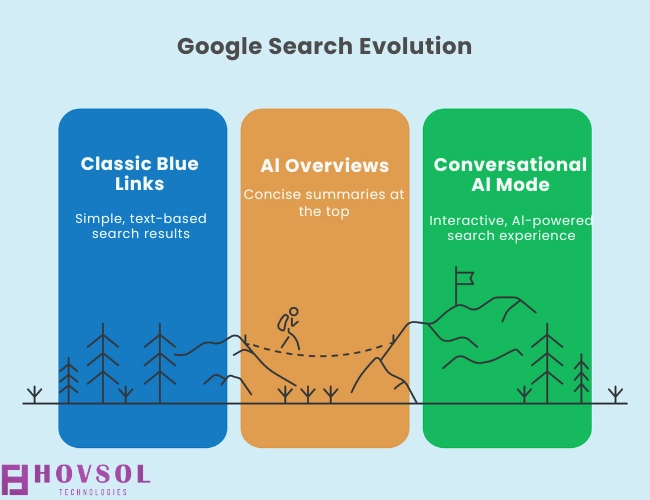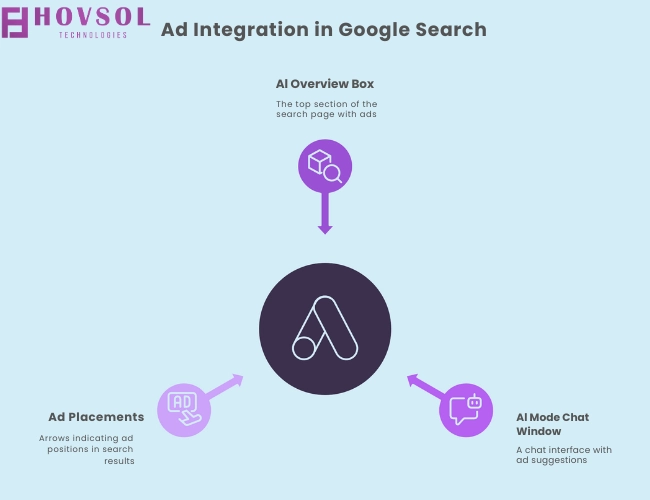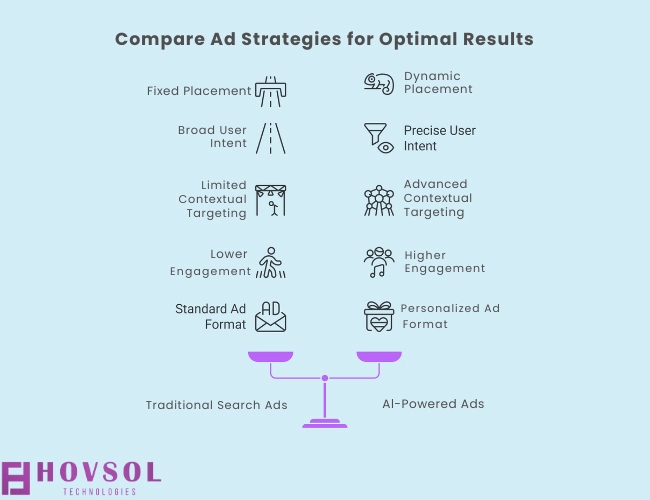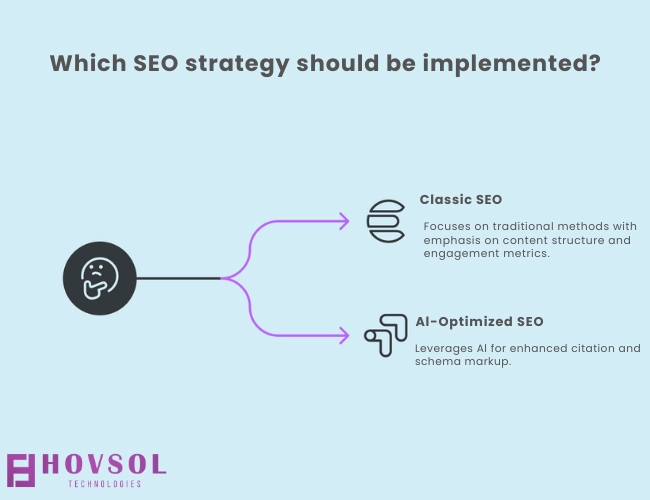Remember when Google was just a list of blue links? Ah, simpler times! If you’ve noticed your search experience becoming more conversational and full of AI-generated summaries, you’ve officially entered the era of Google AI Overviews and the new AI Mode. And if you’re thinking, “Great, another thing to master in digital marketing,” you’re not wrong—but this time, the rules are changing for everyone.
Google isn’t just making search smarter; it’s transforming advertising itself by embedding ads directly into AI experiences. For entrepreneurs, marketers, SaaS founders, and investors, this shift isn’t just another feature—it’s a fundamental rewrite of the digital playbook. At HOVSOL Technologies, our approach is to help you navigate these shifts with clarity and foresight.
Key Takeaways
- Google’s AI search is reshaping both search and advertising, with AI Overviews and AI Mode now blending organic answers and paid ads.
- Success now means optimizing for AI—use Q&A content, schema markup, and campaign types eligible for dynamic, intent-driven ad placements.
- Marketers must adapt strategies to track AI-powered journeys and stay agile as Google’s automation and agentic features accelerate.
The Dawn of a New Search Era: Understanding Google’s AI Leap

Google’s latest updates to Search—including AI Mode—are explained in this official blog post from Google.
Google’s leap into generative AI in search responds to a clear change: users want direct answers, not just links. AI Overviews (formerly SGE) and AI Mode have turned Google into a true intelligence provider, giving users fast, nuanced responses—often without needing to click away. In 2025, AI Overviews are already showing up in more than 30% of searches in the U.S. and UK for complex questions.
What Are AI Overviews and AI Mode?
AI Overviews are AI-generated summaries placed at the top of search results, often with citations and follow-up prompts. These snippets boost engagement and trust, as users see concise, cited answers instantly. AI Mode goes further: it’s a chat-style, conversational interface with advanced reasoning and multimodal abilities, powered by Gemini 2.5. Here, Google breaks down your query into subtopics, explores the web in depth, and brings back hyper-relevant insights—all in one conversation.
Want to dive deeper into the evolution of SEO, AEO, and GEO? Check out our complete breakdown here for a closer look at how search strategies are changing in the AI era.
Why Is Google Embedding Ads in AI?

Generative AI is expensive to run—OpenAI and Google both spend billions yearly. As more searches are satisfied with AI answers, Google’s pay-per-click model faces disruption. Embedding ads inside AI Overviews and AI Mode ensures Google can still deliver value to advertisers and keep search free. In Q1 2025 alone, Google generated $66.89 billion in ad revenue, with much of this now hinging on these new AI formats.
Where Ads Will Live (and Win) in the AI Landscape
The big shift: Google now places ads inside AI Overviews and AI Mode—sometimes above, sometimes below, and sometimes right inside the AI-generated summary itself. These aren’t static banners but dynamic placements based on the user’s intent and the summary’s content.
AI Overviews: Prime Sponsored Real Estate
Ads can appear within the summary, above, or below. For example, if someone searches “how to clean grass stains,” the AI Overview will summarize the answer and may include sponsored cleaning products right after, all clearly labeled as ads.
AI Mode: Conversational Commerce
In AI Mode, ads are contextually woven into conversational responses. Imagine asking for website tips—AI Mode may suggest a guide and then showcase a sponsored tool, all in one interaction. This is rolling out as an experiment but is expected to reach wide adoption by late 2025.
Comparison Table: Traditional Search Ads vs. AI-Powered Ads
| Feature | Traditional Search Ads | AI-Powered Ads in Overviews/Mode |
|---|---|---|
| Placement | Beside/above search links | Inside/around AI summaries |
| User Intent Signal | Short queries, keywords | Conversational, in-depth queries |
| Contextual Targeting | Keywords only | Query + summary content |
| Engagement | Clicks, impressions | Multi-touch, conversational |
| Ad Format | Text, image, shopping | Text, shopping, chat-style |

Why These Placements Matter for Marketers
- Intent-rich exposure: Longer, conversational queries mean your ads are matched to higher intent prospects.
- Contextual precision: AI leverages both the query and summary to place your ad more organically.
- Increased trust and engagement: Ads shown within trusted, cited summaries feel more like helpful recommendations than distractions.
- Persistent discovery: As users dig deeper with follow-up questions, your ad has more opportunities to reappear.
Your Playbook for Winning with Google AI Ads

Get Eligible with the Right Campaign Types
You can’t just “opt in” for these placements. Instead, eligibility depends on running:
- Search campaigns with broad match & Smart Bidding
- Performance Max
- AI Max for Search (beta)
- Shopping, Local, or App campaigns
Broad match and AI-powered tools help capture natural, conversational queries—critical for AI experiences.
Optimizing Content for AI Visibility
To rank in AI Overviews:
- Write with a Q&A mindset—AI likes concise, answer-focused content.
- Implement schema markup (FAQ, HowTo)—it boosts your “citation-worthiness.”
- Prioritize expertise and trust (E-E-A-T)—Google wants reliable, well-formatted info.
- Maintain strong bottom-of-funnel pages—ensure users who do click can convert.
Difference Table: Old vs. New SEO for Google AI
| Approach | Classic SEO | AI-Optimized SEO |
|---|---|---|
| Main Goal | Rank for keywords | Be cited and surfaced by AI |
| Content Structure | Long-form, mixed length | Concise, scannable, Q&A |
| Markup | Optional | Essential (schema, FAQ, HowTo) |
| Engagement Metric | Clicks | Goal/task completion |
Advertiser Control: Know Your Limits
Currently, you cannot manually opt-in for ads inside AI Overviews or AI Mode—Google’s AI determines eligibility and placement. Your best play is to optimize your content, campaigns, and feeds to feed Google’s AI with high-quality, relevant info.
Real-World Gaps & Additional Insights
1. Tracking Conversions in AI-Driven Results Marketers now face a challenge: post-click user journeys can be fragmented as users interact directly with AI. Implement advanced analytics to track conversions after an AI-assisted interaction (look for tools that measure both clicks and goal completions).
2. Privacy and Compliance AI-driven ads increase the complexity of privacy and data transparency. Stay ahead by using transparent ad disclosures, and make sure your privacy policy covers AI interactions.
3. International Rollout Nuances AI Overviews and AI Mode don’t roll out the same way everywhere—monitor how features appear in your target markets, and test your campaigns in both U.S. and international accounts for coverage.
4. Preparing for the Future Start exploring ways to make your brand “AI-ready” for next-gen features (like booking directly via AI or integrating with Project Mariner partners). Watch for Google’s updates—2026 is likely to see even more automation and agentic AI.
Schema Markup & FAQ Optimization
Don’t forget to add schema (FAQ, HowTo, etc.) to help Google’s AI find and cite your content. Schema is a major differentiator in the age of AI Overviews.
Want to understand how advanced GEO content strategies can boost both human and AI search visibility? Read our GEO Content Strategy guide.

Conclusion: Adapt, Optimize, and Stay Ahead
The AI-powered search and ad ecosystem is here. Those who cling to “the old way” risk invisibility, while those who adapt will thrive. Embrace broad-match campaigns, AI-driven copy, schema-rich content, and a focus on trust and task completion.
Want a strategy built for the AI search future? Connect with HOVSOL Technologies and stay ahead of the curve—let’s make your next campaign the benchmark for innovation and results.
FAQs
What’s the difference between AI Overviews and AI Mode in Google Search?
AI Overviews give quick, AI-written summaries at the top of search results. AI Mode is a more advanced, chat-style interface where you can ask follow-up questions and get deeper, personalized insights.
How does Google show ads in these new AI search experiences?
Google now puts ads above, below, and inside AI Overviews and in AI Mode chats. These ads are marked as “Sponsored” and chosen based on what you’re searching for, aiming to be more helpful and relevant.
What are the main pros and cons for advertisers?
Advertisers get access to more targeted, intent-driven users, but lose some control over ad placement. There’s more visibility, but also a risk of users finding answers without clicking to websites.
Which campaign types are eligible for ads in AI Overviews and AI Mode?
Eligible campaigns include Search with broad match and Smart Bidding, Performance Max, AI Max for Search (beta), and Shopping, Local, or App campaigns.
What new AI features are part of AI Mode?
AI Mode includes “Deep Search” (for expert-level, multi-source answers), “Live” (real-time visual search via your camera), and “Agentic” features that automate tasks like booking tickets or filling out forms.
How is Google working to build trust and accuracy in AI Overviews?
Google limits answers on sensitive topics, is quick to fix mistakes, and constantly works to improve the quality and reliability of AI-generated answers.
How do these changes impact SEO and organic content?
SEO is now about being cited by AI, not just ranking for keywords. Use Q&A formats, schema markup, and make your content easy for AI to understand and reference.
What does all this mean for digital marketing?
Search is becoming more conversational and AI-driven. Advertisers and marketers need to adapt by focusing on AI-optimized content, campaign automation, and new ways of measuring engagement.




